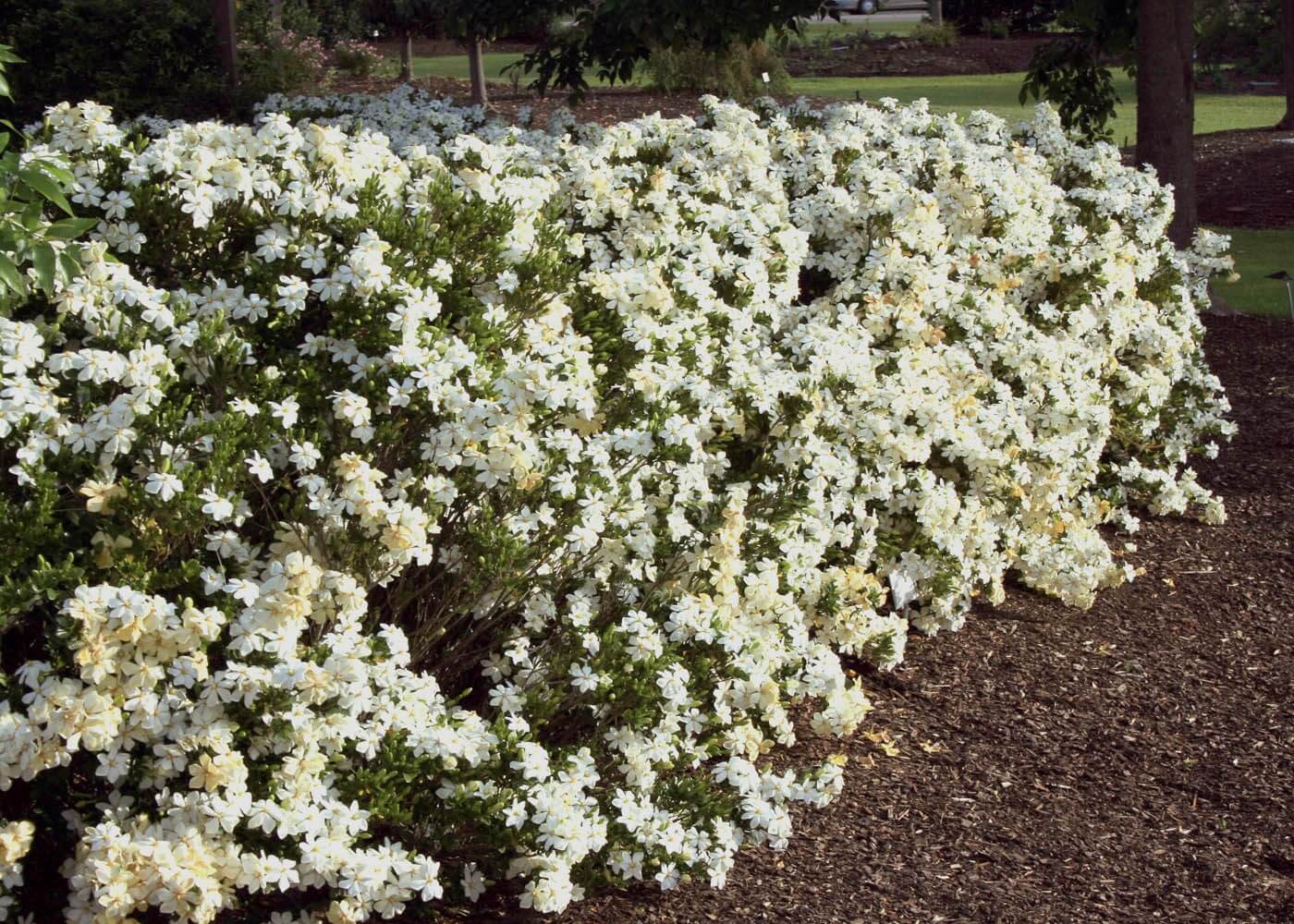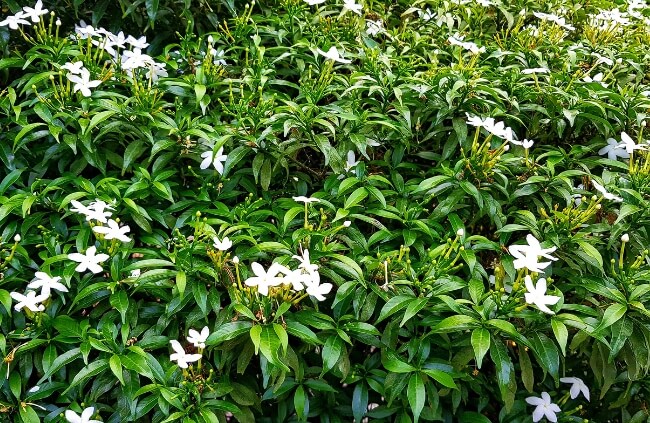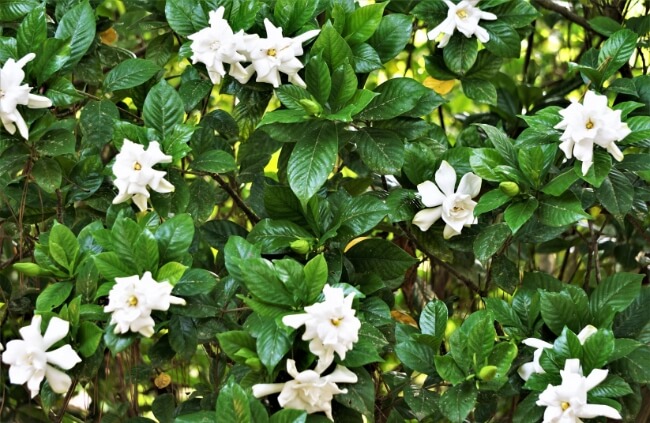Gardenias are a highly misunderstood plant, most commonly grown as dwarf cultivars or mounding shrubs, but there are over a hundred species, some growing as trees, and others as tall shrubs, and nearly all of them can be pruned into hedges of varying height, form and structure.
To grow your own gardenia hedge, you just need to follow some basic rules for gardenia plant care and pair that up with good pruning practices. To keep things simple, we’ve run through everything you need to know about growing a tight and floriferous scented gardenia hedge in this easy-to-follow guide.
More...

Family: | Rubiaceae |
|---|---|
Genus: | Gardenia |
Species: | Various |
Common Names: | Gardenia |
Origin: | Tropical and subtropical Africa, Asia, Australia, Madagascar, and the Pacific Islands |
Location: | Outdoor |
Type: | Flowering shrubs or small trees |
Growth: | Up to 2 m tall (most will reach 0.5 - 1 m) |
Sun requirements: | Light shade |
Foliage Colour: | Green |
Flower Colour: | White |
Flowering: | Spring to autumn |
Edible Parts: | Edible flowers, leaves and fruits |
Maintenance level: | Medium |
Poisonous for pets: | Toxic to cats and dogs |
Why Grow a Gardenia Hedge?
Gardenias are known for their scent, and in many ways are best grown as shrubs so you can enjoy their structure from every angle. However, if they are well-pruned and well-fed, they will form one of the most stunningly scented hedges imaginable.
There are several native species of gardenia too, which make lovely additions to any garden, both for you as a gardener, and any wildlife you’d like to encourage.
Gardenia tends not to be very fast growing, so while it might take a little longer to establish than some hedging plants, they are much easier to control once they mature.
Choosing the Best Gardenia for Hedges
Nearly all species of gardenia will grow well in Australian gardens, and there are plenty to choose from. If you’re interested in native plants, check out our guide to Australian native gardenias to grow at home, but if you want to look further afield, there aren’t many that can compete with Gardenia jasminoides, native to southeast Asia.
When it comes to hedging though, there are a few specific considerations to make when choosing the best gardenia variety for a hedge. Specifically, growth rate and leaf size, as these will make a big difference to how neat your hedge will look after each prune, as well as making it easier to prune in the first place.

Source: extension.msstate.edu
1. Gardenia augusta ‘Magnifica’
Growing to a manageable 2 m tall, Gardenia ‘Magnifica’ is one of the best gardenias to grow as a privacy hedge, without any compromise on flower intensity. By pinching out your Gardenia ‘Magnifica’ to maintain its form, rather than pruning with secateurs, you can encourage even more flowers and will benefit from a much more natural-looking hedge.
2. Gardenia jasminoides ‘Radicans’
This dwarf form of gardenia is as popular around the world as a houseplant as it is as a garden shrub, but have you considered a low-growing hedge to make the most of these highly scented flowers, without losing light?
Gardenia ‘Radicans’ won’t grow taller than 80 cm, and are usually limited to 50 cm tall. Planted 30 cm apart, they quickly form a dense low hedge to provide a neat border to patios, or even in raised beds as a low-maintenance feature.
3. Gardenia jasminoides ‘Veitchii’
Better known as Everblooming Gardenia, this reliable cultivar is noted for its highly fragrant flowers and dense foliage, often flowering for twelve months of the year, provided there are good warm temperatures through winter.
With a good moisture retentive mulch on well-draining soil, it will really thrive and can be grown as a reasonably compost hedge, reaching around 1-1.5 m tall.
4. Gardenia jasminoides ‘Crown Jewel’
At just 90 cm tall, this compact shrub makes a great quick hedge. Planted about 40 cm apart, they quickly fill in any gaps, and can be pruned as soon as they show signs of new growth.


Get Your Free Guide:
Master Growing Australian Natives eBook
A Must Have Complete Guide for Every Australian Garden
Get Your Free Guide:
Master Growing Australian Natives eBook
A Must Have Complete Guide for Every Australian Garden
Flowering reliably through warmer months, this dramatic short hedging plant is an ideal choice for welcoming gardens without interrupting the view.
5. Gardenia jasminoides ‘Golden Magic’
If you want something a little bit different, Gardenia jasminoides ‘Golden Magic’ should deliver. Its yellow flowers break the mould of white flowers we’re more familiar with from gardenias.
At 2 m tall, it’s compact enough to be controllable, but tall enough to offer privacy along with highly fragrant flowers that are slightly softer than the ice white blooms of most cultivars.
How to Grow a Gardenia Hedge
Gardenia hedges are easy to plant. Just use basic shrub planting rules regardless of the size or age of the plants you start with; dig holes twice as deep, and twice as wide as the container, and aim for slightly acidic conditions for more fragrant flowers.
Where to Plant Your Gardenia Hedge
Gardenias flower best with protection from the afternoon sun. In reality, this is hard when planting a hedge, and it will mean that your gardenia hedge flowers better on one side than the other.
For low-growing gardenia hedges, and area-dividers, just make sure they have plenty of moisture, and maybe some protection or shade from the house during hot summer afternoons.

Gardenia Hedge Spacing
Spacing your gardenia hedges depends on the cultivar you choose. For taller growing gardenias, they will need quite generous spacing, something up to 1.5m apart to avoid excess competition. However, this will mean waiting longer for a tight-knit hedge.
Short-growing gardenias can be planted more tightly. We usually pop them about 70 cm apart, so by the end of their first season, they should have started growing into one another.
Preparing the Soil for a Gardenia Hedge
Gardenias are one of many shrubs that require two conflicting conditions – good drainage, and reliable moisture. On clay soils, that’s pretty much impossible without serious improvement, and on sand, it means adding plenty of organic matter.
Droughts will deeply limit Gardenia flowering, and sodden roots will cause root rot that can affect the entire plant. However, with some good preparation, you can easily make any gardenia suitable home for a gardenia hedge.
- Start by digging a trench that’s twice as deep as your gardenias’ current pots, and twice as wide.
- Back fill the trench with a mix of well-drained soil and compost (sandy soil just add compost, clay soil, add grit, sand and compost – consider using gypsum for longer term clay soil improvement)
- Plant your gardenias into the hole, filling around them with the same compost mix.
- You’ll be left with excess garden soil, but this can be used to fill raised beds, pots or hanging baskets, depending on the type of soil you took out.
How to Propagate Gardenias
Gardenia can be propagated easily at home from cuttings, and roots reasonably quickly. With proper care and attention, you can take a series of gardenia cuttings in spring, and they’ll be ready to plant as a hedge at the same time next year.
To take gardenia cuttings, you’ll need rooting hormone, perlite, and low-nutrient potting soil (sieved, weed-free, used compost works well as an alternative).
- Start by cutting a 10-15 cm shoot with no signs of a flower or flower bud.
- Trim the cutting by removing any leaves from the bottom half, and cutting the base so it’s just below a node.
- Dip the cut end in the rooting hormone.
- Push it gently into a pot filled with 50% perlite and 50% compost.
- Keep it away from direct sunlight, but in a bright warm spot, and water to keep the potting mix moist but not damp.
- After about a month it should give resistance when tugged because the roots have started forming.
- When roots poke out of the base of the pot, move it to a larger container with better compost, and care for each cutting until they’re about 1-2 ft tall.
- Pinch new growth regularly to form a bushier shape for planting as a hedge later.
How to Care for Your Gardenia Hedge
Gardenias should be planted on well-drained soil, so they’re never sat in water, but even when established, they want watered weekly. Along with watering, you can buy some great gardenia fertilisers online, and some attention to soil conditions, maintaining a slightly acidic pH.

Feeding and Mulching a Gardenia Hedge
It’s best to start out with a pH of around 6.0 when planting Gardenias, but you can alter this later and even after planting with soil additives, coffee grounds and slightly less rotted manures which offer some ammonia to the soil.
Avoid lime and any alkaline feeds at all costs, as they really, really will not respond well to this, and can rapidly reduce flower production, and even drop leaves in neutral to alkaline conditions.
Watering Your Gardenia Hedge
Water gardenia at least once a week in summer. Avoid damp or pooling conditions by watering deeply once a week, rather than sparsely every day. This goes for nearly every plant in the garden, but is especially important for gardenia.
If you notice any pests, reduce that frequency so the soil surface dries out, reducing common pests who lay larvae in moist soil like mealy bugs and shield bugs
Pruning a Gardenia Hedge
Gardenia pruning is really quite simple, and incredibly intuitive. Unlike rose hedges or climbing plants, you simply prune gardenia as soon as it finishes flowering. This avoids removing developing buds and encourages a fresh flush of flowering growth for the next year.
Gardenias flower on new growth, so their fresh flush of growth that develops in late autumn and early spring (sometimes through a warm winter) will host all the flowers for the following year.
While young, you can pinch out any excessively leggy growth to just inside the main shape. This encourages more lateral and tight-knit growth and, if done in spring or summer, may continue to flower in autumn.
Problems and Pests with Gardenia Hedges
Most common garden pests can pose a risk to gardenia as they are rich in chlorophyll and their leaves store a good amount of moisture when they’re well-kept. This means that aphids and thrips will thrive on new shoots and young leaves, and mealybugs, shield bugs and leaf miners can feast on more mature foliage.
All can be treated with neem oil as an organic insecticide but, generally speaking, regular pruning and considered watering on well-drained soil will reduce the chances of these common pests.
Well-drained conditions are also key to preventing root rot, the most common cause of fungal problems both underground and above ground. Early signs are yellowing leaves, and bud drops.
Some organic fungicides (including neem) can treat topical problems, but if root rot has completely set in, it’s best to remove the plant and replace the soil before replanting a healthy specimen.
Gardenia Hedges Frequently Asked Questions

When do gardenia hedges flower?
Gardenia hedges can actually flower all year round but typically flower from spring through to autumn in most parts of Australia. Cooler summers and warmer winters will prolong flowering significantly.
Can gardenias grow in full sun?
Gardenias can grow perfectly well in full sun, but flower best with some protection from midday and early-afternoon sun, especially in high summer.
Are gardenias poisonous to dogs?
Every species of gardenia is toxic to dogs, cats, and horses thanks to alkaloids present in their berries, saponins in their sap, crocetin in their flowers, and gardenoside, glycosides, and geniposide present in every part of the plant.
Are gardenias edible?
Gardenia flowers, while toxic to pets, are edible for humans in moderation. Their flowers can be dried and used to make teas, or eaten fresh for a brighter, zestier flavour.
Wrapping Up Our Gardenia Hedge Guide
Whether you’re growing native species or the more widely available Gardenia jasminoides, the fragrant scent of Gardenia will fill your garden for months on end. Plus, with so many cultivars to choose from, all of distinctly different heights and forms, you can adapt your gardenia hedge to suit your garden perfectly.
Published on August 28, 2023 by Lorri Hopkins
Last Updated on September 20, 2025




